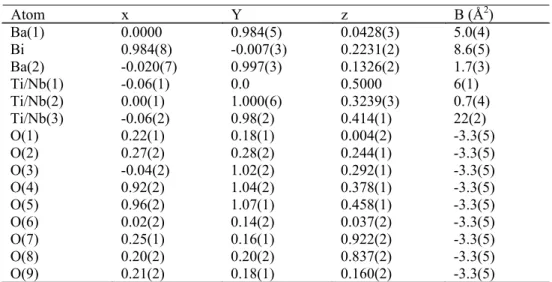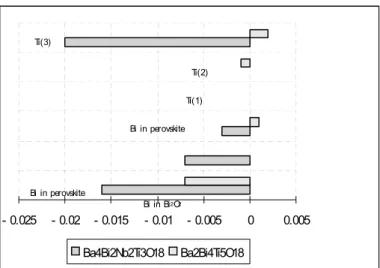Structure Refinement of Five Layers Aurivillius
Compound: Ba
4Bi
2Nb
2Ti
3O
18Ismunandar*,ϒ & Edi Mikrianto*,#
*Department of Chemistry, FMIPA, Institut Teknologi Bandung Jl. Ganesha 10 Bandung 40132
Abstract. The room temperature structures of the five layers Aurivillius phase Ba4Bi2Nb2Ti3O18 has been refined from X-ray powder diffraction data using the Rietveld method. The structures consist of [Bi2O2]2+ layers interleaved with perovskite-like [Ba4Nb2Ti3O16]2- blocks. The oxides was found to be orthorhombic (SG B2cb); a = 5.5017(8), b = 5.5031(8), c = 50.363(3) Å, Rp = 25.53 Rwp = 35.54 Rexp = 29.30 RBragg = 9.92. The structural features of the compound is found similar to that of other layered Aurivillius compounds. Using the available structural data the ferroelectric properties could be explained and strategies to find good ferroelectric materials could be inferred.
Keywords: Aurivillius phase; Ba4Bi2Nb2Ti3O18; Rietveld method; X-ray powder
diffraction.
1 Introduction
Layered bismuth oxides commonly referred to as the Aurivillius phases have been known for more than 50 years (1). Recently there has been renewed interest in the ferroelectric properties of the Aurivillius phases due to their potential applications in nonvolatile computer memories (2). The Aurivillius phases, which have the general formula Bi2An-1BBnO3n+3, n = 1, 2, 3,… can be
described as resulting from the regular stacking of [Bi2O2] slabs and
perovskite-like [A
2+
n-1BnB
O3n+3]2- blocks. The integer, n, describes the number of
sheets of corner-sharing BO6 octahedra forming the ABO3-type perovskite
blocks.
In comparison to the n = 2 and 3 oxides, which have been extensively studied (3-5), very little is known about the higher order n = 4 or 5 oxides. The synthesis and ferroelectric behavior of the n = 5 oxides A2Bi4Ti5O18 (A= Sr, Ba
and Pb) were first reported in 1962 (6-8). There were conflicting reports about the existence of single phase samples of Ba2Bi4Ti5O18; Subbarao reported that
this is in fact a mixture of the four layer oxide BaBi4Ti4O15 and BaTiO3 while
ϒ
to whom correspondence should be addressed (ismu@chem.itb.ac.id)
Aurivillius claimed Ba2Bi4Ti5O18 could be obtained as a single phase. Recently
Irie et.al. reported the preparation and ferroelectric properties of single crystals of A2Bi4Ti5O18 (A= Ba and Pb) (9). They indexed the patterns of both
compounds in B2ab with a ≈ b ≈ 5 Å and c ≈ 50Å; no other structural parameters were reported.
In order to fill those gaps, recently we prepared a series of novel four and five layer Aurivillius compounds (10). We also carried out structural refinement of representative five layer compound (11). In the present paper, we report refinement of Ba4Bi2Nb2Ti3O18, one of the previously prepared oxides. The
objective of the current reports is twofold. Firstly, it reports on the structure of an Aurivillius compound which has non Bi exclusively in the perovskite layers. Secondly, it illustrates that using laboratory source X-ray diffractometer sufficient important structural information could be obtained. The results of the determination could be used to explain the ferroelectric properties of the compounds. This eventually could be used in the search of optimal materials for ferroelectric memory.
2 Experimental
Polycrystalline samples of Ba4Bi2Nb2Ti3O18 was prepared by the solid state
reaction of stoichiometric quantities of the appropriate alkaline BaCO3, Bi2O3,
and TiO2 as described previously (10). Powder X-ray diffraction pattern was
measured in MicroAnalysis machine using Cu Kα radiation (1.54056 Å) with graphite monochromator, in the range of 10.000 deg to 90.000 deg with 0.020 deg step size. Each step was counted for 6.00 sec. The Rietveld refinement (12) was carried out using Rietica (13). Sixty six parameters were refined in the final refinement, including cell parameter, positional parameter, peak shape, and thermal parameters. The R factors (Rp), the weighted R factor (Rwp), the Bragg
R factor (RBragg) and Rexp are defined as follows:
( io ic)
io
y -y
p y
R = ∑∑ ;
(
i io ic)
2 i io
1 2 w (y -y )
wp w y
R = ∑∑ ; io ic io
(I -I ) Bragg I
R = ∑∑ ;
io
(N-P)
exp Y
R = ∑∑ , where yio and yic are the
observed and the calculated intensities, wi is the weighting factor= 1/yio, Iio and
Iic are the observed and the calculated intensities of hkl reflection, N is the total
number of yio data, P is the number of parameters.
3
Results and Discussion
Structural parameter for Sr2Bi4Ti5O18 (11) was used as a starting model in the
values, suggested that a good fit has been obtained. The negative value obtained for O atoms thermal parameters is believed as a result of insensitivity of X-ray data to light atoms, despite that all O atoms were assumed to have the same thermal parameter. The same reason can be used to explain the relatively large estimated standard deviation (esd) for O atoms position.
1000
500
0
In
te
n
si
ty
90 80
70 60
50 40
30
Two Theta (degrees)
Figure 1 Rietveld refinement plot showing the observed (×), calculated (solid line) neutron diffraction profiles and their difference for Ba4Bi2Nb2Ti3O18 at room temperature. The tick marks show the positions of the allowed Bragg reflections in space group B2cb.
The observed cell parameters are larger than Ba2Bi4Ti5O18 (11) in agreement
with the larger ionic radii of Ba2+ than Bi3+, as could be seen on the VIII coordinated Bi3+ and Ba2+ (14) (XII coordinated Bi3+ ionic radii is unavailable). The degree of the orthorhombic splitting, given by 2( )
( )
a b a b −
+ , obtained for this
compound is smaller than those obtained for A Bi Ti O (A = Ca, Sr and Pb), but larger than BaBi Ti O . This can be explained using tolerance factor, t, defined as
2 4 5 18
4 5 18
( ) 2 ( )
A O
B O r r
r r
t= ++ where r is the radius of the 12-coordintate A cation, r ,
the radius of the 4 coordinate oxygen anion and r the radius of the six-coordinate Nb /Ti cation. As the size of the A-type cation increases through the series Ca (1.34) < Sr(1.44) ≈ Pb(1.49) < Ba(1.61 Å) then t increases, from less then unity in CaBi Ti O to greater than 1 in BaBi Ti O
A 2+ O
B
5+ 4+
4 5 18 4 5 18. Further
Ba(1) 0.0000 0.984(5) 0.0428(3) 5.0(4)
Bi 0.984(8) -0.007(3) 0.2231(2) 8.6(5)
Ba(2) -0.020(7) 0.997(3) 0.1326(2) 1.7(3)
Ti/Nb(1) -0.06(1) 0.0 0.5000 6(1)
Ti/Nb(2) 0.00(1) 1.000(6) 0.3239(3) 0.7(4) Ti/Nb(3) -0.06(2) 0.98(2) 0.414(1) 22(2)
O(1) 0.22(1) 0.18(1) 0.004(2) -3.3(5)
O(2) 0.27(2) 0.28(2) 0.244(1) -3.3(5)
O(3) -0.04(2) 1.02(2) 0.292(1) -3.3(5)
O(4) 0.92(2) 1.04(2) 0.378(1) -3.3(5)
O(5) 0.96(2) 1.07(1) 0.458(1) -3.3(5)
O(6) 0.02(2) 0.14(2) 0.037(2) -3.3(5)
O(7) 0.25(1) 0.16(1) 0.922(2) -3.3(5)
O(8) 0.20(2) 0.20(2) 0.837(2) -3.3(5)
O(9) 0.21(2) 0.18(1) 0.160(2) -3.3(5)
Table 1 Positional and thermal parameters for Ba4Bi2Nb2Ti3O18, orthorhombic ( SG B2cb); a = 5.5017(8), b = 5.5031(8), c = 50.363(3), Rp = 25.53 Rwp = 35.54 Rexp = 29.30 RBragg = 9.92.
Ba(1) O(5) O(1) Ti/Nb(1) Ba(1) O(5) O(6) Ti/Nb(2) O(7) Ba(2) O(4) O(8) Ti/Nb(3) O(9) O(3)
Bi O(2) Bi O(3)
O(8) Ti/Nb(3) O(9) Ba(2) O(4) O(6) Ti(2) O(7) Ba(1) O(5) O(1) Ti(1)
Figure 2 Structure of Ba4Bi2Nb2Ti3O18.
Figures 2 shows the structures of BaBi Ti O4 5 18. Although high esd result in the
relatively low accurate bond length and angles, the result also suggest that the local environments of the three crystallographically distinct Ti atoms are noticeably different. The outermost MO6 octahedra are highly distorted. Similar
features are also observed in other Aurivillius oxides (3-5, 11). These features could be attributed to efforts to compensate the underbonding of Ti in the outermost octahedra.
The contribution of each constituent ion to the total spontaneous ferroelectric polarisation is calculated as: PS (m ×i Δy ×eQ ) Vi i
i
=
∑
, where m is the sitemultiplicity, Δy is the atomic displacement along the b axis from the corresponding position in the tetragonal structure, Q e is the ionic charge for the ith constituent ion, and V is the volume of the unit cell. Figure 3 compares the polarisation calculation results for
i
i
i
Ba2Bi4Ti5O18 and Ba4Bi2Nb2Ti3O18. This
clearly shows that the substitution of Ba for Bi in the perovskite enhances the polarisation. This is in contrast with the result of similar substitution in two layer Aurivillius, where the substitution results in reducing the total polarisations (15). Although it should be noted that considering the estimated standard deviation and the contribution of other ions, the total polarisations could be reduced. However, the precise oxygen atoms positions would be needed, i.e. neutron powder diffraction experiment is needed.
- 0.025 - 0.02 - 0.015 - 0.01 - 0.005 0 0.005 Ba4Bi2Nb2Ti3O18 Ba2Bi4Ti5O18
Bi in Bi2O2
Ti(3)
Ti(2)
Ti(1)
Bi in perovskite
Bi in perovskite
Figure 3 The polarisation contribution in Ba4Bi2Nb2Ti3O18 compared with those in Ba2Bi4Ti5O18.
which exclusively occupy the inner of perovskite layers result in enhancement of ferroelectricity. Further work to determine the precise position of the light atoms using powder neutron diffraction is being carried out and will be reported in due course.
Acknowledgements
Ismu thanks to HB X and TWAS for supporting the work.
References
1. Aurivillius, B., Ark. Kemi 1, 499 (1949).
2. de Araujo, C. A. P. et al, Nature (London) 374, 627 (1995).
3. Ismunandar, Hunter, B. A. and Kennedy, B. J., Solid State Ionics, 112 (3-4), 281 (1998).
4. Macquart, R., et al, Integrated Ferroelectric, 2003.
5. Hervoches, C. H. and Lightfoot, P., J. Solid State Chem., 153, 66 (2000). 6. Subbarao, E. C., J. Am. Ceram. Soc. 45, 564 (1962).
7. Subbarao, E. C., J. Am. Ceram. Soc. 45, 166 (1962). 8. Aurivillius, B., Fang, P. H., Phys. Rev. 126, 893 (1962).
9. Irie, H., Miyayama, M. and Kudo, T., J. App. Phys, 90, 4089 (2001). 10. Edi Mikrianto and Ismunandar, JMS, 2003, submitted.
11. Ismunandar, et al, J. Neutron Res., 2004, in press.
12. Young, R. A. “The Rietveld Methods”, OUP Inc., NY, 1993.
13. Howard, C. J. and Hunter, B. A., 1998 A Computer Program for Rietveld
Analysis of X-Ray and Neutron Powder Diffraction Patterns (NSW,


